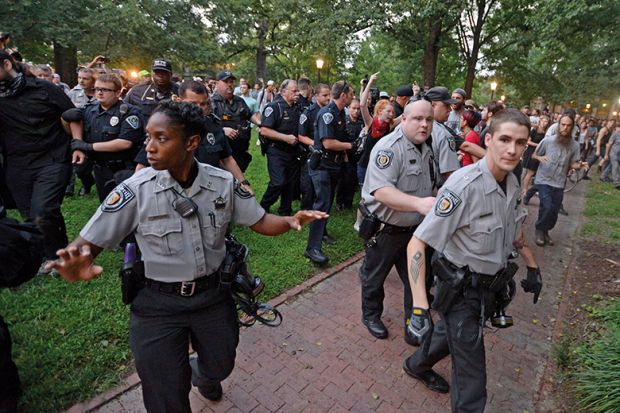As political protests at or near American university campuses have become increasingly contentious, experts hired by one state proposed a solution suitable for Hollywood: a “mobile force platoon” of 40 specially trained police officers to swoop in and respond to emergencies at its 17 public higher education institutions.
The $2 million-a-year (£1.5 million) plan, which also would have required $500,000 of equipment, was turned down in response to alarm from faculty, staff and students. But it was a dramatic sign of growing concerns about safety and security that are propelling campus police worldwide into a new and far more conspicuous role.
“The landscape has changed and you can see it in the evolution of our organisation, which started out more as the association of security and parking directors,” said Jerry Murphy, who will run another new symbol of this evolution: a Global Center for Campus Public Safety. Currently being established by the International Association of Campus Law Enforcement Administrators (IACLEA), this will study and share lessons from the escalating problems faced by campus police around the globe.
“Certainly large public universities now have pretty significant law enforcement agencies in terms of their size and function,” Mr Murphy said. “Some have several hundred officers, so they’re the size of municipal police departments. Part of that is a reflection of the range of issues that they have to manage now.”
These include protests and vandalism that culminated with the toppling of a memorial to Confederate soldiers at the University of North Carolina, which also brought down the university’s chancellor and resulted in the proposal, in December, for a statewide strike force.
At the University of Virginia, campus police were criticised for failing to anticipate the violence at a white supremacist rally that left a counter-demonstrator killed. People who were protesting against a controversial speaker at the University of California, Berkeley started fires and smashed windows.
US university police are also contending with mass shootings and undergoing training to respond to synchronised attacks; 167 people were killed and 437 wounded in incidents on campuses nationwide involving guns between 2001 and 2016, according to the Citizens Crime Commission of New York City – with the five-yearly total increasing by 241 per cent over that period.
They’re dealing with incidents of sexual assault, sometimes-fatal “hazing” rituals at fraternities, a growing number of hate crimes and an epidemic of mental health concerns. And intensifying natural disasters are requiring them to undertake activities such as building barricades to stop flooding and patrolling campuses without electricity or communication.
The heightened focus on campus safety has its origins with the 11 September 2001 terrorist attacks and accelerated after the shooting in 2007 that killed 32 people on the campus of the Virginia Polytechnic Institute and State University, said Kristen Roman, chief of police at the University of Wisconsin-Madison.
Since then, Ms Roman said, “campuses have bolstered their efforts to make sure they have the adequate [police] staffing, training, and awareness”. Meanwhile, social media instantly conveys when emergencies happen elsewhere. “So it calls to our attention the what-ifs: are we prepared if that was to happen on our campuses?”
Not everyone is happy about the growing prominence of university police. There are concerns about invasions of privacy at places such as Ohio University, which is installing 400 security cameras in and around residence halls, and resistance to arming campus officers, propelled by incidents such as the fatal shooting of a black motorist by a white policeman who worked for the University of Cincinnati; murder charges brought in that case have resulted in two mistrials.
In an incident at Portland State University in Oregon, two campus police officers fired 17 times at a legally armed black civilian, who was trying to break up a fight, and who also died. Those officers were not charged.
“There’s a sense that we want to have a campus police department and we want it to be ready, but at the same time a perspective against over-militarising our campuses,” said Mr Murphy. “The fact that campus public safety agencies struggle with these things is just a struggle inherent in policing.”
Other campus police have been video-recorded doing such things as pepper-spraying peaceful student protesters, or have been suspended for sleeping during their shifts. A 21-year-old University of Utah student was fatally shot by a former boyfriend, who then shot himself, even after she repeatedly reported his threatening behaviour; an investigation found fault with campus police, whose training the university promised to improve.
Such heightened policing is stretching tight budgets. Several institutions have attempted to levy security fees on student organisations who invite controversial speakers, but courts have blocked this as an unconstitutional violation of free speech.
And there remain attitudes of “are you a real cop, you’re glorified security”, said Ms Roman, who has led training for IACLEA in responding to students with mental-health issues. “We’ve heard it all.”
Still, said Mr Murphy, “the more we can learn from the challenges and study the responses by campus public safety agencies – what works, what doesn’t work – that can move us to greater professionalism”.
后记
Print headline: US campus police rise to mounting safety concerns




